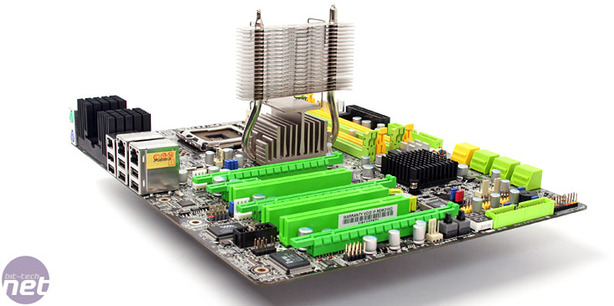Stability
As usual for our stability testing we set the BIOS to its optimised default settings, then dropped in a quad-core Core 2 Extreme QX9650 and loaded it with Prime95's torture test. No additional fans were used – the north bridge, south bridge and PWM heatsinks were all left passive, apart from the airflow from the Zalman CNPS9700 CPU fan.The system held out just fine, so we looped 3DMark06 over the top of it and came back a day later to find it was still running all the programs and was still responsive – a great result.
We had previously had problems when running a quad-core Core 2 Extreme processor when we tested the DFI during our XFX nForce 790i Ultra SLI review – it was generally very unstable running just stock speeds and optimised memory timings. The latest BIOS seems to have fixed this though as our board works perfectly now.
Value
We found the DFI LANParty LT X48 T2R for a very reasonable £155.88 (including VAT). Considering the Asus Rampage Formula and Gigabyte GA-X48T-DQ6 we reviewed last week are £20 more expensive, the DFI certainly looks great value for an enthusiast. However the Asus Maximus Formula has dropped in price because of the Rampage and now undercuts the DFI by a few pounds. Given the choice though, the DFI looks better, features a newer chipset and is likely to have better community support for beta BIOSes.In fact, the Asus board is probably the best match to the DFI – they both feature enthusiast-orientated BIOSes with plenty of tweaking options and come with some pretty crazy hardware extras. While DFI probably has the edge in the former, Asus generally gives you more bits in the box.
Other "enthusiast" products include the nForce 790i Ultra SLI, which is £80 more expensive but features support for the more popular Nvidia SLI technology instead of the ATI CrossFire support that comes as part of the X48 chipset.

It is worth noting that the DFI LANParty X38 T2R is some £15 cheaper though – the basic BIOS for both are very similar, although I'd guess not entirely interchangeable. The board layout and features are identical though – it's simply one chipset swapped out for another. If that's still too expensive there is the LANParty DK X38-T2R which features normal CPU power phases instead of the digital ones and is just £120.
There's very little between the X38 and X48 chipsets, you generally pay a premium for the newer model with the latest revision. Personally, I'd go for the X48 just because I'd want the latest bit of kit, but it's a hard justification when that £15 could be spent on a better heatsink for example – it's the difference between something decent and a Thermalright Ultra eXtreme 120.
Final Thoughts
For a DDR2 board the gaming performance is very good, outperforming even the Nvidia nForce 780i SLI board in all of our gaming tests. It can't keep up with the DDR3 boards, but buying 4GB of DDR2 is still a fraction of the cost of even 2GB of DDR3 – that alone will offer significant headroom for games as well.It is more expensive than its X38 brethren and you'd be hard pressed to tell the two apart if they were standing side by side. However, if you were concerned about price you'll probably want to wait for the P45 launch anyway. It's not power friendly either, but DFI has never claimed to even care – it's not about the latest bandwagon, it's about being true to its core, of which it does in spades. The incredible north bridge heatsink and its simple interchangeability is no greater example of this – you're free to replace it with anything you like because they are no heatpipes.
If you love your DFI boards then you'll be onto a winner with the LANParty LT X48 T2R – everything you need out of Intel's X48 chipset is provided and there's a lot of fun and time investment to be had with it. After talking to BIOS engineers and others in DFI's QA team, the limitations we've been finding are essentially chipset level and there's plenty of beta BIOS out there to try on DFI communities that only add to its true, core-enthusiast appeal. However finding these places and knowing who to ask isn't the most obvious thing on earth – DFI should fill its manual with more BIOS details, overclocking tips and support forum links for new DFI owners can dive into. This "left to get on with it" is harsh to say the least.
All in all, it's well priced, well featured, great looking and it can be very stable. While our concern this that if you lack patience or don't have much time to learn then look elsewhere – the LANParty LT X48 T2R is certainly not for everyone, and while we think DFI can do better in the experience as a whole, it'll still be perfect for some of you.
- Performance
- x
- x
- x
- x
- x
- x
- x
- x
- -
- -
- 8/10
- Features
- x
- x
- x
- x
- x
- x
- x
- x
- x
- x
- 10/10
- Value
- x
- x
- x
- x
- x
- x
- x
- x
- -
- -
- 8/10
- Overall
- x
- x
- x
- x
- x
- x
- x
- x
- x
- -
- 9/10

DFI LANParty LT X48 T2R

MSI MPG Velox 100R Chassis Review
October 14 2021 | 15:04









Want to comment? Please log in.